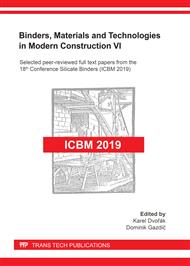p.119
p.125
p.131
p.141
p.149
p.157
p.165
p.171
p.177
Hygrothermal Behaviour of Inorganic Binder-Based Board Materials
Abstract:
Currently, the use of board materials as a material intended for the dry construction of building structure cladding in the building industry has become widespread. The most common types of board materials include wood-based boards (particle, fibre, laminated / plywood, oriented strand boards [OSB]), cement-bonded particleboards and gypsum plasterboards or gypsum fibre boards. In the case of board materials based on inorganic binders, these are most often represented by boards in which the fillers used are bonded by plaster or cement. Wood can then be used as filler, which is predominantly an assortment of inferior-quality trees or comes from a short rotation coppice, treated by various technological processes. Microstructure and material composition have the greatest influence on the physical and mechanical properties of the boards. The use of the boards in the internal or external environment is determined by their individual properties. Another indicator for the possible use of boards is the form of moisture with which the board comes into contact after installation into the structure. For the external environment, the boards have to withstand mainly liquid moisture; in contrast, in an internal environment, the boards come into contact mainly with air humidity. The diffusion properties of the individual products are also crucial for the overall design and use of the boards for structure cladding.
Info:
Periodical:
Pages:
157-164
Citation:
Online since:
July 2021
Authors:
Keywords:
Price:
Сopyright:
© 2021 Trans Tech Publications Ltd. All Rights Reserved
Share:
Citation:


